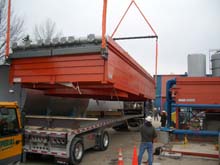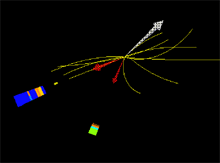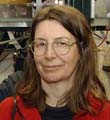 | Thursday, February 16, 2006 |
|
Thursday, February 16
Friday, February 17
*** Announcement *** |
|
Extended Forecast |
Secon Level 3 |
|
Thursday, February 16 -Tomato Florentine -Grilled Chicken Cordon Bleu Sandwich -Chimichangas -Chicken Marsala -Smoked Turkey Melt -Italian Sausage Calzones -SW Chicken Salad w/Roasted Corn Salsa |
|
Thursday, February 16
Wednesday, February 22
Chez Leon Menu |
| Fermilab Today is online at: http://www.fnal.gov/today/ Send comments and suggestions to today@fnal.gov Fermilab Today archive Hurricane Relief Page Fermilab Today PDF Version Fermilab Result of the Week archive Fermilab Safety Tip of the Week archive Linear Collider News archive Fermilab Today classifieds Subscribe/Unsubscribe to |
|
Global Grid Service Meets Gigabyte-Per-Second Challenge
| ||
|
||
|
In a breakthrough for scientific grid computing, the Worldwide LHC Computing Grid (WLCG) collaboration officially announced the successful completion of a service challenge that sustained a continuous flow of physics data on a worldwide grid infrastructure at rates of up to one gigabyte per second. The maximum sustained data rates achieved correspond to transferring one DVD's worth of scientific data every five seconds.
The data were transferred from CERN in Geneva, Switzerland to 12 major computer centers around the globe. Over 20 other computing facilities were also involved in successful tests of the global grid service for real-time storage, distribution and analysis of particle physics data. The completion of this challenge is a key milestone on the way to establishing the necessary computing infrastructure for the Large Hadron Collider (LHC), the world's largest scientific instrument, scheduled to start operation in 2007.
|
|
From The Courier News Online,
February 16, 2006:
Jane Wilson, 89, wife of Fermilab founder, passes on BATAVIA — They came from the top laboratories and colleges all over the world. And when the physicists, the most brilliant minds of their day, arrived in Batavia, they were faced with 6,800 acres of long, empty farm fields. Robert Wilson, a former Princeton professor, needed to convince these men the future was in that prairie. As the first director of Fermi National Accelerator Laboratory, Wilson had to show them they could live and work in the Fox Valley. Luckily, at Robert's side, was a great saleswoman: his wife, Jane. According to those who knew her, it was Jane Wilson who turned open land into a place where physics and families could flourish. "I think with some people it's called Bob's greatest work," said Fermilab archivist Adrienne Kolb. "Jane supported all of it."
Jane Wilson, 89, died Tuesday in Ithaca, N.Y., from congestive heart failure.
|
|
W Bosons light up the Standard Model |
|||
| |||
|
Particle physics is the science that attempts to understand the basic
building blocks of matter and the interactions that govern their behavior.
Numerous experiments, and years of research, have led to a very successful
theory called the Standard Model. In the Standard Model matter is made of
quarks that interact by exchanging particles called bosons.
The interaction of one of these bosons, the W, with another, the photon, is being studied with the DZero experiment. By doing so, particle physicists are testing the structure of the theory that describes their interactions. The Standard Model describes exactly how the W boson and photon interact. If something unexpected is observed, then the Standard Model is incorrect, and a new theory must be found. The Tevatron collider at Fermilab smashes beams of protons and antiprotons together. In these collisions, the quarks (from the protons) annihilate antiquarks (from the antiprotons) to produce new particles, which can then be studied. Sometimes the quark and antiquark annihilate to produce a W boson which then radiates a photon, providing a means by which physicists can study the actual W-photon interaction. In this study the scientists examined the spectrum of energies of the photons produced in this way, and compared this to the predictions of the Standard Model. The data are in excellent agreement with the Standard Model. The Tevatron continues to produce record amounts of data and the DZero team plans to continue studying this process in ever greater precision. It is only by testing our theories to ever higher degrees of precision that we can hope to further our understanding of nature. |
|||
| |||
| Result of the Week Archive
|
|
February 13 - 15 - Two stores provided 41 hours and 26 minutes of luminosity. - MCenter running without analyzing magnet. - Store 4642 quenched. Read the Current Accelerator Update Read the Early Bird Report View the Tevatron Luminosity Charts
|
|
New issue of symmetry The February issue of symmetry is now available online.
Prairie Restoration
International Folk Dancing
|




